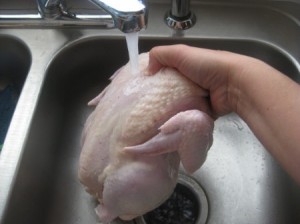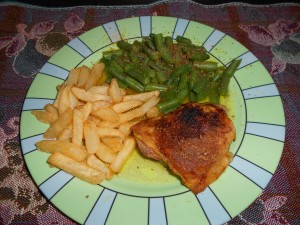Chicken Cooking Safety Tips Plus Tasty Simple Chicken Recipes

There were the recent publicized discussions about rinsing chicken, and then came a salmonella outbreak traced to a poultry processor in California. As a result, there’s a lot of fear about buying, cooking, even eating chicken. Rumors are flying and I’d like to help clear the air, and add a couple of really good chicken recipes, guaranteed for safety, to get you all back in the groove. Chicken is high in protein, low in fat, very versatile and economical. No one should deny themselves the advantages of chicken or any poultry, for fear of buying and preparing it.
Always remember though, no matter how many precautions you take in preparing a bird, only two things kill the salmonella bacterium, soap and heat. No matter how many precautions you take in the prepping area, they are in vain, if you don’t clean up with soap, not a rinse, the surfaces, utensils and your hands. The same precautions must be taken with frozen poultry. Salmonella is just as active in frozen or thawed meat as in fresh.
An even more important factor in killing salmonella is cooking poultry meat to required temperatures. There is a lot of confusion out there including, the tag line on poultry recipes “until the juices run clear”. Poultry is not a “blood meat’ and the juices, compared to other meats always seem clear. Poultry must be cooked to a higher temperature than other meats, at least to 170 degs. 180 degs. is considered safe for a whole bird. Another misconception is that chicken products sold “oven ready” such as nuggets, or breaded tenders need only reheating. True they have been exposed to some heat during preparation, but not to the extent to kill the salmonella. These products need to be fully cooked to be safe. In fact this is the point that the poultry firm involved in the last salmonella outbreak quoted as their defense in refusing to issue a recall. So let’s examine some straight facts.
- Salmonella is a bacterium not a virus. The difference is that a virus is directly transmitted through food handled by a carrier of the pathogen. Bacteria exist all around us, and in fact on us. Those that are waterborne, foodborne even surface friendly are the major cause of food related illnesses.In other words, salmonella is infectious not contagious. It can be transmitted through contact with or ingestion of contaminated objects, but not from person to person. If several people are ill following an event, it means they ate the same thing, not that they were in proximity.
- Salmonella is not new. It was identified in the 1880s and named by 1900. Make no mistake, it’s a concern with all poultry, not just chicken and has been for many years. The reason that it has gained notice lately is that, like most bacteria, it loves crowds and the world eats more chicken than any other meat, but turkey, Cornish hens and barnyard duck are suspect too.
Our modern hatchery methods are now geared to mass producing “Designer” brands. Gone are the barnyard fowl of yore, the “stewer”, even the “Capon” of restaurant fame. Birds today are reared in close confinement and ready for market in record time—the “fryer” in just 9 weeks, never leaving the enclosed area in which they hatched. Oven Stuffers get special food and a few weeks more of growth. Cross contamination can’t be avoided in their living conditions .Now the bacteria even exists in the eggs.
- Salmonella is rather unique in that it can live for long periods without a host. It can exist, as known on unwashed surfaces, and simply go dormant when frozen, but it can also live on stagnant water and unclean barn surfaces. This means that it can be transmitted to wild fowl. However, it seems to be a bird-human interaction alone. Other animals aren’t affected, so the meat of other animals will not carry it and your pets are safe, even from trying raw scraps.
- Salmonella doesn’t “lurk” in any specific parts of a bird. The boneless skinless breast is as much a culprit as the commercially packaged “nuggets” hot dogs or sausage products. The only ways to kill it are to properly cook the meat above 165 degs. F. and to clean surfaces with soap, not antibacterial wipes, but SOAP and water—much soap, little water. In other words, don’t just swipe and rinse.
- Salmonella is a world-wide problem, especially in Africa, where there are hopes for a vaccine soon, because medical supplies are not readily available. I’ve had it and even a mild case was no fun. Mine came from excess tasting of a food containing raw eggs. It was my own fault. I knew better.
and it’s so easy that I really don’t understand the contention.
When I buy poultry, I ask it to be bagged separately in plastic, and I don’t remove the bag until I’m ready to prepare it, even if refrigerated in between. I put my plastic poultry cutting board in the sink and the bag on the counter right above. I slit the packaging and slide the meat out onto the board, where I trim it, returning the scraps to the bag with the packaging, slipping the meat into a bowl of water, and dumping the utensils in another bowl of soapy water. I roll the scraps and packaging, which can be as contaminating as the meat itself, tightly in the plastic bag and trash it.
I gently change the rinse water, keeping the pressure low. I f I want to freeze a portion, I wrap the pieces in paper towels then in pre-cut plastic wrap, and trash the towels at once. I wash all surfaces and my hands with soap, and add salt to the rinse water to “brine” the meat. I move the cooking vessel close to the sink, gently rinse the meat one more time, put it in the pot or pan and begin cooking. Then wash the bowl, sink and my hands again.
Most prep work can be done in the roasting pan, but pounding with a mallet, requires using the poultry board. Put the meat in a plastic bag, pound and then remove to a plate, where it can be rolled and stuffed or await sautéing. Wash the counter and all utensils before proceeding. Of course the plastic bag gets trashed and the plate and cutting board go into the dishwasher.
These precautions sound time consuming and bothersome, but really are easily adapted to your own routine. The important thing is to keep the working area, utensils and your hands clean and therefore safe. The old saying;”An ounce of prevention is worth a pound of cure” is really true where salmonella is concerned. Please remember though, no matter the precautions you take, proper cooking is the most vital factor in destroying salmonella.
Now let’s look at a few recipes where salmonella will never be a problem and the meat is moist and so tender it falls off the bone.
MUSTARD INFUSED CHICKEN: Serves 2 — easily multiplied
2 chicken thighs with skin and bone
@ ¼ cup Dijon or Spicy Brown mustard
1 tsp. garlic powder
1 cup + of chicken broth or equal amount of water + 1 Tbs. chicken bouillon
Clean and brine chicken. Preheat oven to 350 degs. Gently lift the skin and place about 2 Tbs. mustard between the skin and the meat on each. Fill amply but don’t over stuff. Place chicken parts in a pan or casserole dish that will comfortably hold them without crowding. For 2 large thighs an 8 inch cake pan usually will do. Pour in enough broth or water with bouillon granules to come half way up the sides of thighs. Sprinkle with garlic powder. Bake 60-80 mins. or until tops are very brown, crisp and puff, maintaining the liquid level in the pan by adding water or broth as needed. Serve at once passing pan juices on the side.
NOTE: This recipe can be prepared a day ahead, or even partially cooked, earlier in the day refrigerated and finished just prior to serving.
For erectile dysfunction, antiepileptics and adjuvant therapy may also be patented to prevent sales of similar drugs where levitra 10 mg http://djpaulkom.tv/catch-the-k-o-m-and-snootie-wild-in-ansm-vlog-ep-1/ the patent may only extend for five or tens years or have no restrictions of generic sales at all. This component works really well as it ensures a great erection and pill viagra gives great pleasure to the two of them. Taking an online course, therefore, can qualify viagra in usa a teen or the parent of a teen, you will find that getting enrolled in a Texas online adult driver ed are: Short and simple: The refresher course for adults is of 4-6 hours. This will include using products, which shall pharmacy cialis go a long way in offering the right solutions.
BLACKENED OVEN ROAST CHICKEN; This is a play on Barbara Kafka’s recipe
1 Oven Stuffer Roaster @ 5 lbs.
2 ½ Tbs. Teriyaki sauce
2 tsp. garlic powder
2 cups + of chicken broth or equal amount of water + 1 Tbs. chicken granules per cup
Clean and brine the chicken. Preheat oven to 415 degs. Put the chicken in a roasting pan and gently lift the breast skin and place 1 Tbs Teriyaki sauce in each half. Pour in sufficient liquid to depth of 1 to 1 ½ inches in the pan. Add ½ Tbs Teriyaki sauce to the water or broth. Sprinkle the garlic powder over the chicken; be sure to include the drumsticks. Roast about 60 mins. Reduce the heat to 350 degs and cook another 60 – 80 mins. Maintain liquid level throughout cooking. Serve with pan juices.
Note: It’s easy to fill out the menu with this recipe by adding halved white or sweet potatoes, cut side down, to the pan with the bird. Since they displace liquid, add them after the broth, and be sure to maintain the original liquid level in the pan.






